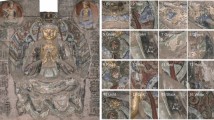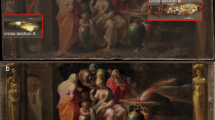Abstract
Most of the wall paintings from Pompeii are decorated with red and yellow colors but the thermal impact of 79 AD Mount Vesuvius eruption promoted the partial transformation of some yellow-painted areas into red. The aim of this research is to develop a quantitative Raman imaging methodology to relate the transformation percentage of yellow ochre (goethite, α-FeOOH) into red color (hematite, α-Fe2O3) depending on the temperature, in order to apply it and estimate the temperature at which the pyroclastic flow impacted the walls of Pompeii. To model the thermal impact that took place in the year 79 AD, nine wall painting fragments recovered in the archeological site of Pompeii and which include yellow ochre pigment were subjected to thermal ageing experiments (exposition to temperatures from 200 to 400 °C every 25 °C). Before the experiments, elemental information of the fragments was obtained by micro-energy dispersive X-ray fluorescence (μ-ED-XRF). The fragments were characterized before and after the exposition using Raman microscopy to monitor the transformation degree from yellow to red. The quantitative Raman imaging methodology was developed and validated using synthetic pellets of goethite and hematite standards. The results showed almost no transformation (0.5% ± 0.4) at 200 °C. However, at 225 °C, some color transformation (26.9% ± 2.8) was observed. The most remarkable color change was detected at temperatures between 250 °C (transformation of 46.7% ± 1.7) and 275 °C (transformation of 101.1% ± 1.2). At this last temperature, the transformation is totally completed since from 275 to 400 °C the transformation percentage remained constant.






Similar content being viewed by others
References
http://pompeiisites.org/en/archaeological-park-of-pompeii/visitor-data/ (last accessed August 2019)
Madariaga JM, Maguregui M, Fdez-Ortiz De Vallejuelo S, Knuutinen U, Castro K, Martinez-Arkarazo I, et al. In situ analysis with portable Raman and ED-XRF spectrometers for the diagnosis of the formation of efflorescence on walls and wall paintings of the Insula IX 3 (Pompeii, Italy). J Raman Spectrosc. 2014;45:1059–67.
Merello P, García-Diego FJ, Zarzo M. Evaluation of corrective measures implemented for the preventive conservation of fresco paintings in Ariadne’s house (Pompeii, Italy). Che Cent J. 2013;7:87–98.
Maguregui M, Knuutinen U, Martínez-Arkarazo I, Castro K, Madariaga JM. Thermodynamic and spectroscopic speciation to explain the blackening process of hematite formed by atmospheric SO2 impact: the case of Marcus Lucretius House (Pompeii). Anal Chem. 2011;83:3319–26.
Maguregui M, Castro K, Morillas H, Trebolazabala J, Knuutinen U, Wiesinger R, et al. Multianalytical approach to explain the darkening process of hematite pigment in paintings from ancient Pompeii after accelerated weathering experiments. Anal Methods. 2014;6:372–8.
Cotte M, Susini J, Metrich N, Moscato A, Gratziu C, Bertagnini A, et al. Blackening of Pompeian Cinnabar Paintings: X-ray Microspectroscopy Analysis. Anal Chem. 2006;78:7484–92.
Marcaida I, Maguregui M, Fdez-Ortiz de Vallejuelo S, Morillas H, Prieto-Taboada N, Veneranda M, et al. In situ X-ray fluorescence-based method to differentiate among red ochre pigments and yellow ochre pigments thermally transformed to red pigments of wall paintings from Pompeii. Anal Bional Chem. 2017;409:3853–60.
Higgings C. Pompeii shows its true colors. https://www.theguardian.com/science/2011/sep/22/pompeii-red-yellow. 2011. The Guardian.
Marcaida I, Maguregui M, Morillas H, Veneranda M, Prieto-Taboada N, Fdez-Ortiz de Vallejuelo S, et al. Raman microscopy as a tool to discriminate mineral phases of volcanic origin and contaminations on red and yellow ochre raw pigments from Pompeii. J Raman Spectrosc. 2019;50:143–9.
Marcaida I, Maguregui M, Morillas H, Fdez-Ortiz de Vallejuelo S, Prieto-Taboada N, Veneranda M, et al. In situ non-invasive characterization of the composition of Pompeian pigments preserved in their original bowls. Microchem J. 2018;139:458–66.
Aliatis I, Bersani D, Campani E, Casoli A, Lottici PP, Mantovan S, et al. Green pigments of the Pompeian artists’ palette. Spectrochim Acta A. 2009;73:532–8.
Marcaida I, Maguregui M, Morillas H, García-Florentino C, Knuutinen U, Carrero JA, et al. Multispectroscopic and isotopic ratio analysis to characterize the inorganic binder used on Pompeian Pink and Purple Lake pigments. Anal Chem. 2016;88:6395–402.
Aliatis I, Bersani D, Campani E, Casoli A, Lottici PP, Mantovan S, et al. Pigments used in Roman wall paintings in the Vesuvian area. J Raman Spectrosc. 2010;41:1537–42.
Cioni R, Gurioli L, Lanza R, Zanella EJ. Temperatures of the AD 79 pyroclastic density current deposits (Vesuvius, Italy). Geophys Res. 2004;109:B02207.
Ruan HD, Frost RL, Kloprogge JT, Duong L. Infrared spectroscopy of goethite dehydroxylation: III. FT-IR microscopy of in situ study of the thermal transformation of goethite to hematite. Spectrochim Acta A. 2002;58:967–81.
Romero P, González JC, Bustamante A, Ruiz Conde A, Sánchez-Soto PJ. Study of the in-situ thermal transformations of Limonite used as pigment coming from Peru. Bol Soc Esp Ceram Vidr. 2013;52:127–31.
Pomies MP, Menu M, Vignaud CJ. TEM observations of goethite dehydration: application to archaeological samples. Eur Ceram Soc. 1999;19:1605–14.
Prasad PSR, Prasad KS, Chaitanya VK, Babu EVSSK, Sreedhar B, Murthy SRJ. In situ FTIR study on the dehydration of natural goethite. Asian Earth Sci. 2006;27:503–11.
De Faria DLA, Lopes FN. Heated goethite and natural hematite: can Raman spectroscopy be used to differentiate them? Vib Spectrosc. 2007;45:117–21.
https://blogs.helsinki.fi/pompeii-project/ (last accessed August 2019)
Lauwers D, Brondeel P, Moens L, Vandenabeele P. In situ Raman mapping of art objects. Phil Trans R Soc A. 2016;374:20160039.
Acknowledgments
The authors would like to thank the Archaeological Park of Pompeii, Expeditio Pompeiana Universitatis Helsingiensis (EPUH), and Naples National Archaeological Museum (MANN) for putting at our disposal the fragments under study.
Funding
This work has been funded by the Spanish Agency for Research AEI (MINECO-FEDER/UE) through the project MADyLIN (BIA2017-87063-P). Iker Marcaida received funding from Basque Government for his predoctoral fellowship. The research leading to these results has also received funding from “la Caixa” Foundation (Silvia Pérez-Diez, ID100010434, Fellowship code LCF/BQ/ES18/11670017).
Author information
Authors and Affiliations
Corresponding author
Ethics declarations
This research does not involve any human participants or animals.
Conflict of interest
The authors declare that they have no conflict of interest.
Additional information
Publisher’s note
Springer Nature remains neutral with regard to jurisdictional claims in published maps and institutional affiliations.
Electronic supplementary material
ESM 1
(PDF 463 kb)
Rights and permissions
About this article
Cite this article
Marcaida, I., Maguregui, M., Morillas, H. et al. Raman imaging to quantify the thermal transformation degree of Pompeian yellow ochre caused by the 79 AD Mount Vesuvius eruption. Anal Bioanal Chem 411, 7585–7593 (2019). https://doi.org/10.1007/s00216-019-02175-5
Received:
Accepted:
Published:
Issue Date:
DOI: https://doi.org/10.1007/s00216-019-02175-5




